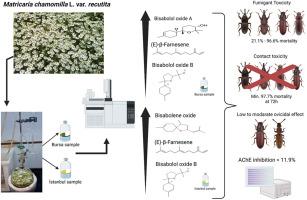不同地区采集的洋甘菊精油对储藏害虫的杀虫和 AChE 抑制活性
IF 2.7
2区 农林科学
Q1 ENTOMOLOGY
引用次数: 0
摘要
对伊斯坦布尔和布尔萨的洋甘菊变种花的精油进行了气相色谱-质谱分析。精油产量分别为 0.32 和 0.18 v/w。伊斯坦布尔样本精油的主要成分是氧化双酚(41.81%)、(E)-β-法呢烯(7.52%)和氧化双酚 B(3.18%)。布尔萨样本油的主要成分是氧化双酚 A(47.76%)、(E)-β-法呢烯(12.75%)、氧化双酚 B(3.47%)和氧化双酚(2.46%)。测定了这些精油的熏蒸和接触杀虫效果,这些效果针对的害虫包括:Sitophilus granarius、S. oryzae (Coleoptera: Curculionidae)、Tribolium confusum 和 T. castaneum (Coleoptera: Tenebrionidae)。此外,还测试了熏蒸油对 T. confusum 和 Oryzaephilus surinamensis(鞘翅目:蚕科)的杀卵作用。在 20% 的施用剂量下,熏蒸剂对 S. granarius、S. oryzae 和 T. confusum 的毒性最高(死亡率为 74.9%-96.6% )。蓖麻油对蓖麻的熏蒸效果低于对其他昆虫物种的熏蒸效果。在施用剂量为 100 μL/mL 时,对 S. granarius 和 S. oryzae 的接触毒性最高(100% 死亡)。在杀卵功效方面,伊斯坦布尔和布尔萨的精油对 T. confusum 卵的有效率为 19.7-37.7%,而对 O. surinamensis 的有效率则分别为 53.4-48.3%。还研究了精油的乙酰胆碱酯酶抑制作用,两种精油的活性都很一般。本文章由计算机程序翻译,如有差异,请以英文原文为准。

Insecticidal and AChE inhibitory activities of Matricaria chamomilla var. recutita essential oils collected from different regions against storage insect pests
The essential oils of the flowers of Matricaria chamomilla var. recutita from İstanbul and Bursa were analyzed by GC-MS. The essential oil yields were 0.32 and 0.18 v/w, respectively. The main components of the essential oil of the İstanbul sample were bisabolene oxide (41.81%), (E)-β-Farnesene (7.52%), and bisabolol oxide B (3.18%). The main components of the oil from the Bursa sample were bisabolol oxide A (47.76%), (E)-β-Farnesene (12.75 %), bisabolol oxide B (3.47%), and bisabolene oxide (2.46%). The fumigant and contact insecticidal effects of these oils were determined against Sitophilus granarius, S. oryzae (Coleoptera: Curculionidae), Tribolium confusum, and T. castaneum (Coleoptera: Tenebrionidae). Additionally, the ovicidal effect of the oils was tested against T. confusum and Oryzaephilus surinamensis (Coleoptera: Silvanidae). The highest fumigant toxicity was observed against S. granarius, S. oryzae, and T. confusum (74.9–96.6% mortality) at the 20% application dose. The fumigant effect of the oils against T. castaneum was lower than the effect observed for other insect species. The highest contact toxicity was observed against S. granarius and S. oryzae (100% mortality) at a 100 μL/mL application dose. In terms of ovicidal efficacy, the oils obtained from Istanbul and Bursa were 19.7–37.7% effective on T. confusum eggs, while this ratio was 53.4–48.3% on O. surinamensis, respectively. Acetylcholinesterase inhibition of the oils was also investigated, and both oils produced mediocre activity.
求助全文
通过发布文献求助,成功后即可免费获取论文全文。
去求助
来源期刊
CiteScore
5.70
自引率
18.50%
发文量
112
审稿时长
45 days
期刊介绍:
The Journal of Stored Products Research provides an international medium for the publication of both reviews and original results from laboratory and field studies on the preservation and safety of stored products, notably food stocks, covering storage-related problems from the producer through the supply chain to the consumer. Stored products are characterised by having relatively low moisture content and include raw and semi-processed foods, animal feedstuffs, and a range of other durable items, including materials such as clothing or museum artefacts.

 求助内容:
求助内容: 应助结果提醒方式:
应助结果提醒方式:


